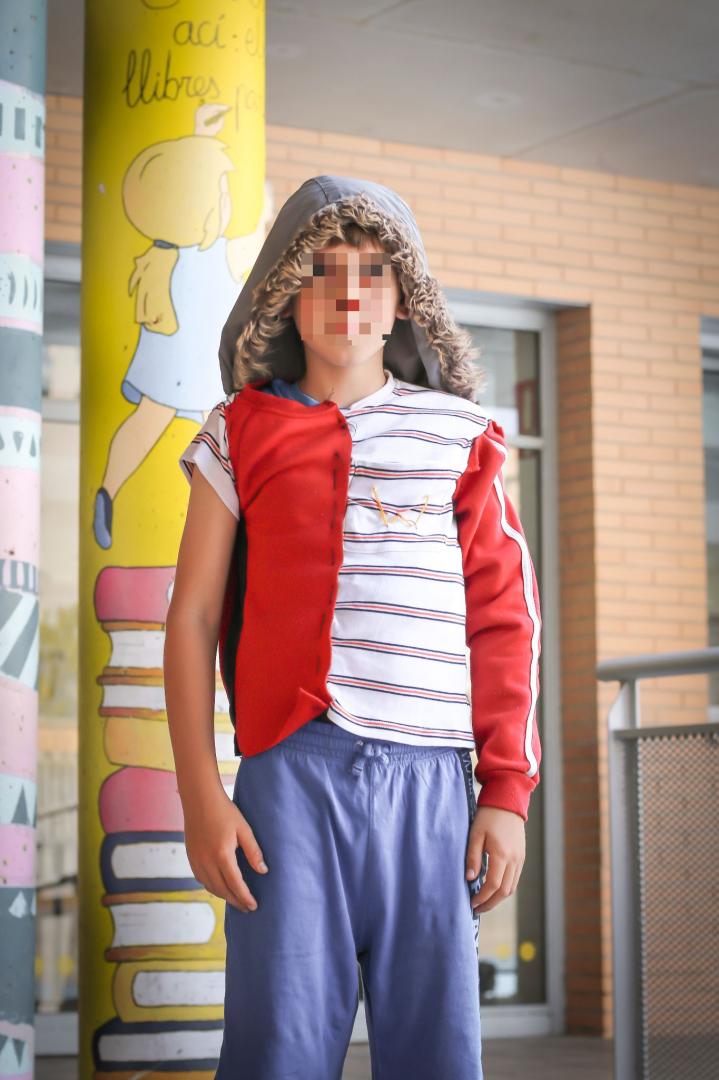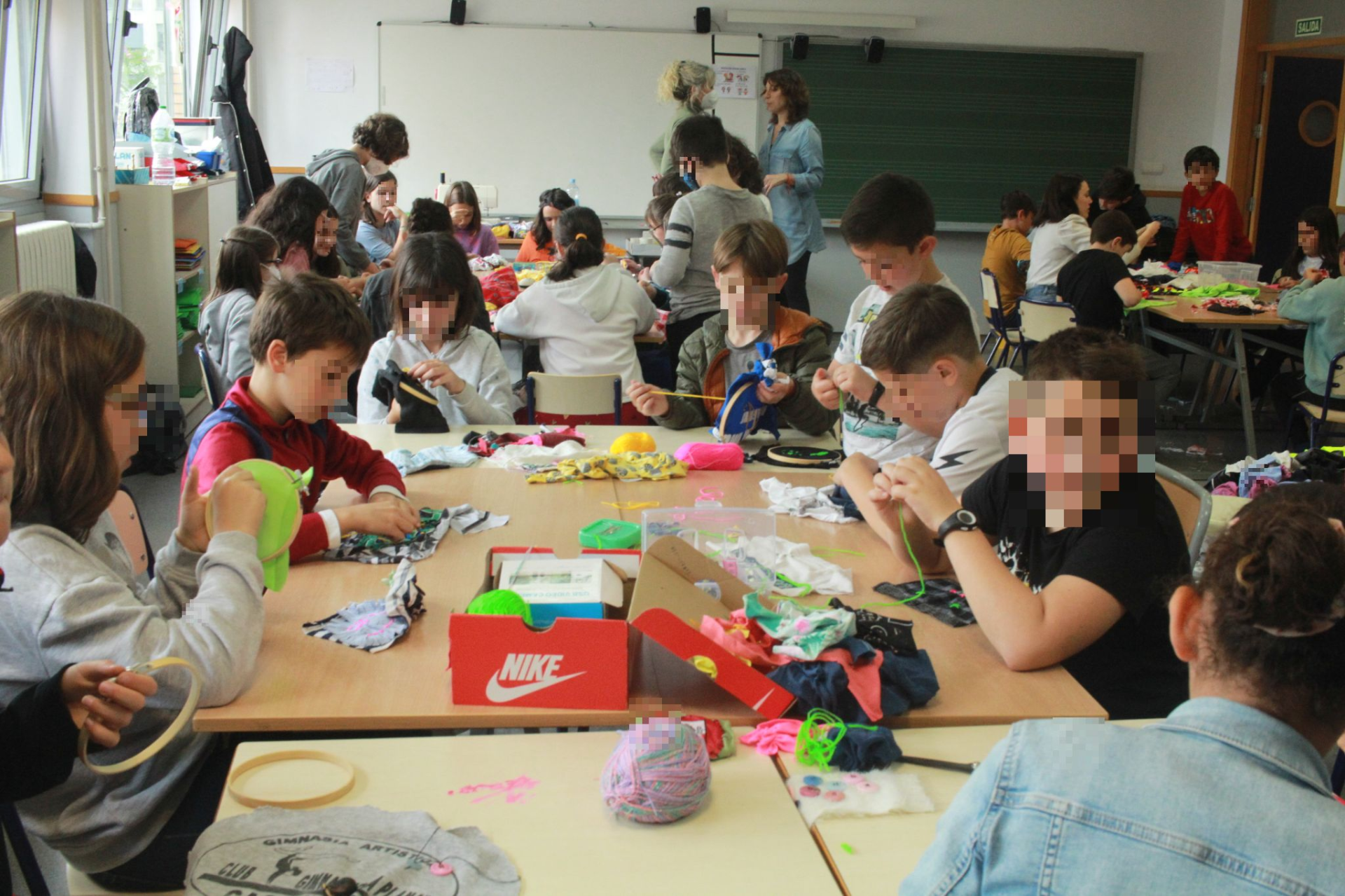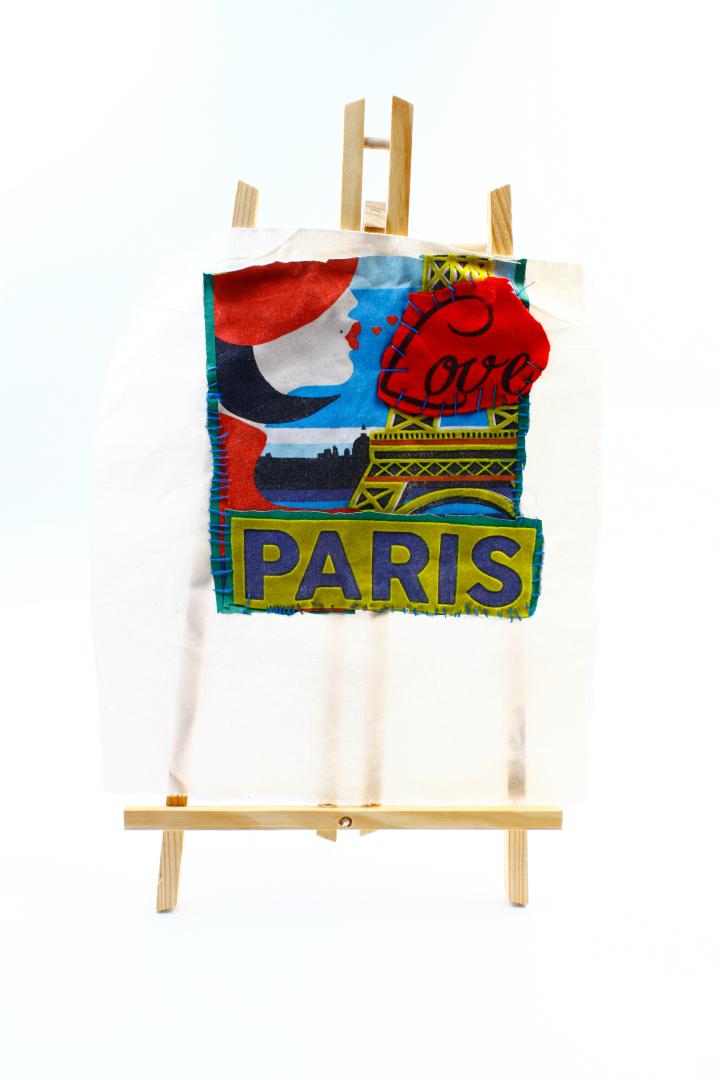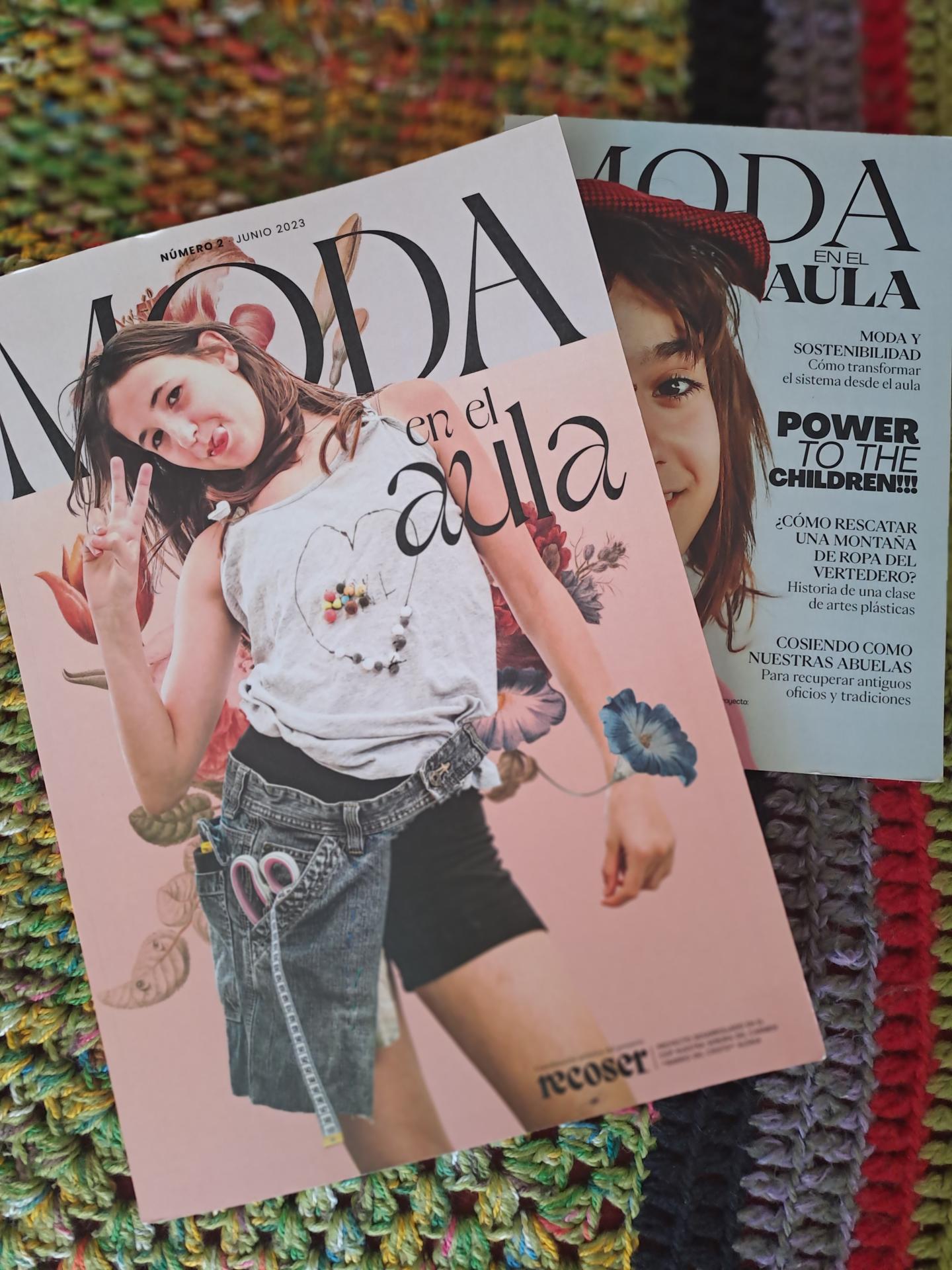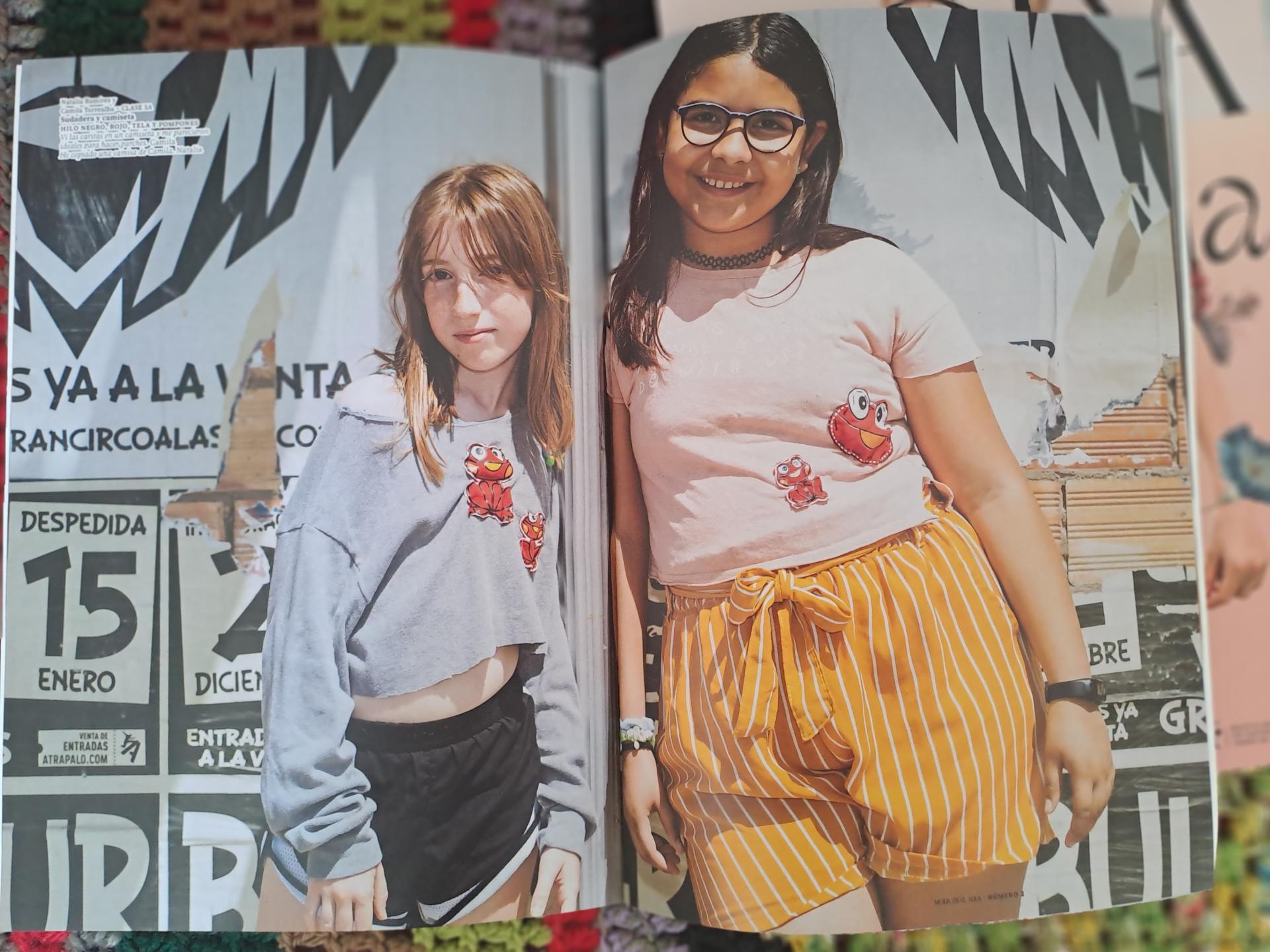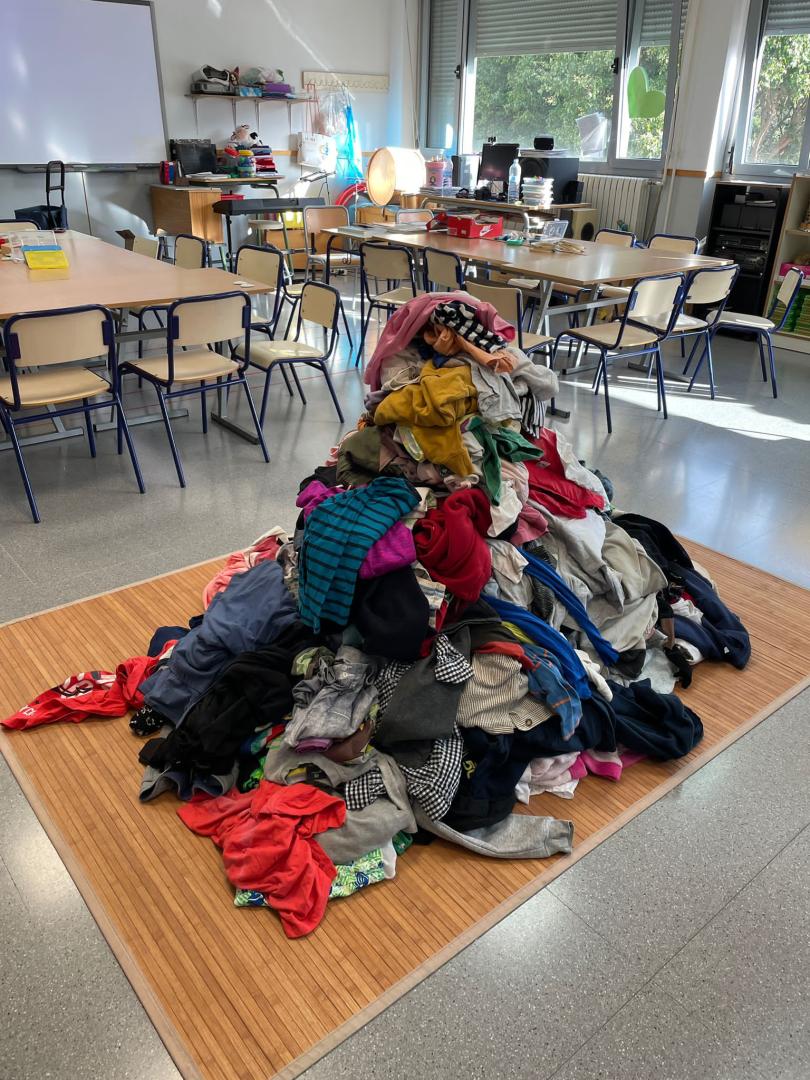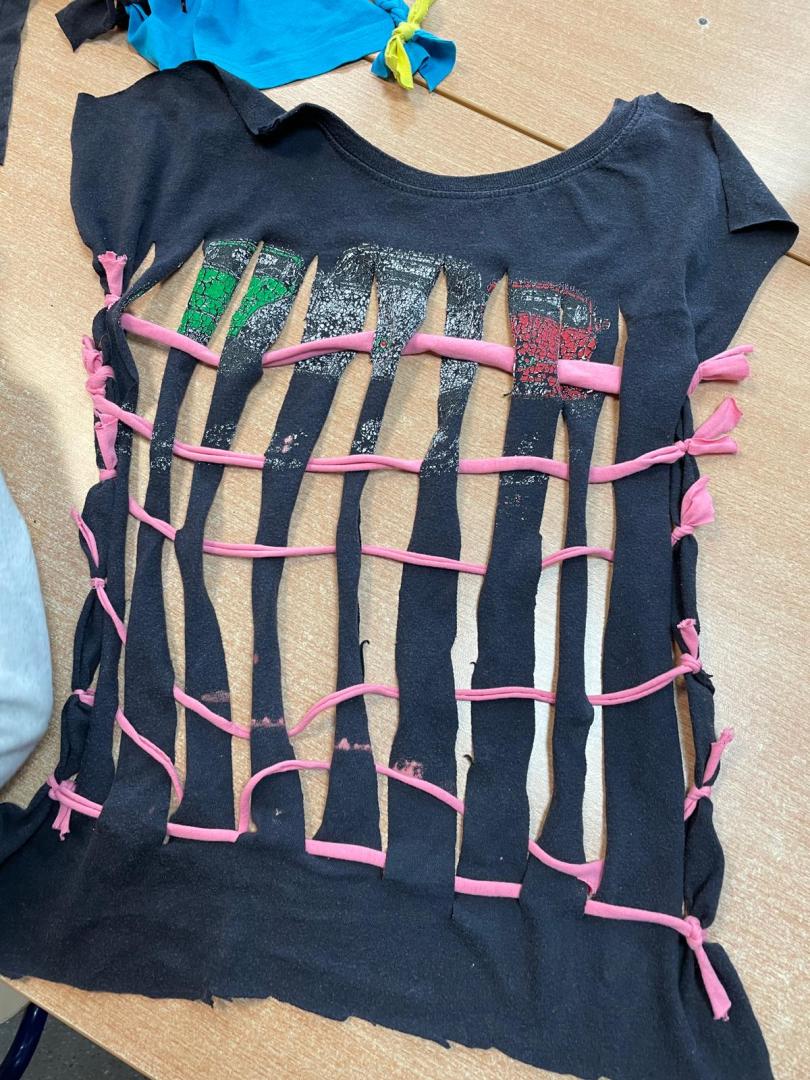Recoser
Basic information
Project Title
Recoser
Full project title
Redesigning the Fashion System in the Classroom
Category
Shaping a circular industrial ecosystem and supporting life-cycle thinking
Project Description
This is a temporary workshop for elementary school students where we explore artistic textile experimentation techniques like yarn bombing, craftivism, and upcycling. By doing this, we reimagine the fashion system in the classroom by making clothes, styles, and magazines using our own materials, tools, and abilities in response to the serious environmental and social problems caused by the fast fashion industry's dominating production and consumption model.
Geographical Scope
Local
Project Region
València, Spain, Spain
Urban or rural issues
Mainly urban
Physical or other transformations
It refers to other types of transformations (soft investment)
EU Programme or fund
No
Description of the project
Summary
Recoser transforms the elementary school into a space for artistic and cultural experimentation to generate sustainable meanings about fashion. We carry out a collaborative process with children to learn basic sewing and dressmaking techniques, and then perform other creative slow fashion practices such as upcycling or yarn bombing.
Here the children learn basic sewing techniques, create their own garments, make photoshoots and catwalks at school and in the streets of the neighborhood and a fashion magazine is published with all the material produced.
Our goal is to redesign the fashion system in the classroom. We understand that fashion is a cultural system created by the industry, stores, influencers, magazines or catwalks. However, we believe that fashion does not belong only to big industries or big design firms: inspired by the great fashion designers, we create our own style, we use our creativity, we reuse the materials that the industry wants in the trash, with the sewing boxes of our homes, collaborating with our classmates, to redesign in our classroom, our own fashion system without exploiting nature or the most vulnerable.
We also understand that the school, as a creative space, is no stranger to the fabric of the neighborhood. The images, ideas and skills they draw from there are the materials and tools with which they build and create something new.
The power of design is so broad that it allows us to reconstruct a system of production and consumption in a sustainable way, while relating to the children's experiences. We believe that when we design we project in our work, everything that defines us, makes us restless and arouses our curiosity. The act of designing helps us to order our ideas, to reflect on solutions to our problems and, by the way, to make our lives beautiful.
Here the children learn basic sewing techniques, create their own garments, make photoshoots and catwalks at school and in the streets of the neighborhood and a fashion magazine is published with all the material produced.
Our goal is to redesign the fashion system in the classroom. We understand that fashion is a cultural system created by the industry, stores, influencers, magazines or catwalks. However, we believe that fashion does not belong only to big industries or big design firms: inspired by the great fashion designers, we create our own style, we use our creativity, we reuse the materials that the industry wants in the trash, with the sewing boxes of our homes, collaborating with our classmates, to redesign in our classroom, our own fashion system without exploiting nature or the most vulnerable.
We also understand that the school, as a creative space, is no stranger to the fabric of the neighborhood. The images, ideas and skills they draw from there are the materials and tools with which they build and create something new.
The power of design is so broad that it allows us to reconstruct a system of production and consumption in a sustainable way, while relating to the children's experiences. We believe that when we design we project in our work, everything that defines us, makes us restless and arouses our curiosity. The act of designing helps us to order our ideas, to reflect on solutions to our problems and, by the way, to make our lives beautiful.
Key objectives for sustainability
Our project focuses on what many researchers increasingly agree: that the transition to sustainability is a change in meanings and value systems.
Therefore, our objectives seek to:
- Recreate cultural systems through artistic and cultural experimentation.
- Explore alternative value structures and meanings to the dominant system of production and consumption known as fast fashion.
- Implement participatory design processes based on the social production of clothing.
We have developed two 6-month interventions in two schools in the Valencian Community, in 2022 and 2023. Thanks to the program Resistencies Artístiques, from the areas of culture and education of the regional government.
In these projects we have carried out activities with more than 300 primary school students. The process consisted of simulating the process of creating fashion from recycled clothes and students who had never had contact with needles, frames, threads and other sewing materials. From there, we moved on to modeling their own creations, photo shoots and editing fashion magazines (see attached).
Once the time came to evaluate, we realized that it is not possible to know if these activities would cause a sustainable change in the children, but when we took a deeper look we found other details, for example, that the children learned textile techniques with ease, despite being a generation with other stimuli such as screens and video games. On the other hand, it was interesting that we did not hear the typical sexist comments that relate sewing to "women's work". In conclusion, we do not know if we will achieve sustainable change, but these types of observations that we have just explained give us hope that a better world is possible.
Therefore, our objectives seek to:
- Recreate cultural systems through artistic and cultural experimentation.
- Explore alternative value structures and meanings to the dominant system of production and consumption known as fast fashion.
- Implement participatory design processes based on the social production of clothing.
We have developed two 6-month interventions in two schools in the Valencian Community, in 2022 and 2023. Thanks to the program Resistencies Artístiques, from the areas of culture and education of the regional government.
In these projects we have carried out activities with more than 300 primary school students. The process consisted of simulating the process of creating fashion from recycled clothes and students who had never had contact with needles, frames, threads and other sewing materials. From there, we moved on to modeling their own creations, photo shoots and editing fashion magazines (see attached).
Once the time came to evaluate, we realized that it is not possible to know if these activities would cause a sustainable change in the children, but when we took a deeper look we found other details, for example, that the children learned textile techniques with ease, despite being a generation with other stimuli such as screens and video games. On the other hand, it was interesting that we did not hear the typical sexist comments that relate sewing to "women's work". In conclusion, we do not know if we will achieve sustainable change, but these types of observations that we have just explained give us hope that a better world is possible.
Key objectives for aesthetics and quality
Exploring new sustainable value systems means transforming our concepts of what is beautiful, of socially constructing our own beauty.
Redesigning the fashion system is precisely about introducing new meanings around what is beautiful.
Through Recoser, we have played at recreating our own standards of beauty. Through this process we have learned that creating beauty is not something fortuitous, but the result of creativity, of the effort to be sustainable, of collaboration and of work and involvement.
That is why we have strived to materialize these ideas in quality products such as our magazines, where we have tried to replicate the quality, in terms of design, content and material characteristics, of the great fashion magazines, but in this case, made by elementary school children.
What the great designers have taught us is that fashion allows this type of experimentation with beauty, understanding that we ourselves can create it.
It has taught us, on the other hand, that aesthetics is not something superficial, but the way in which form is inserted into our lives. Style is necessary because it is our identity, style is the way we seek stability in a changing world.
Redesigning the fashion system is precisely about introducing new meanings around what is beautiful.
Through Recoser, we have played at recreating our own standards of beauty. Through this process we have learned that creating beauty is not something fortuitous, but the result of creativity, of the effort to be sustainable, of collaboration and of work and involvement.
That is why we have strived to materialize these ideas in quality products such as our magazines, where we have tried to replicate the quality, in terms of design, content and material characteristics, of the great fashion magazines, but in this case, made by elementary school children.
What the great designers have taught us is that fashion allows this type of experimentation with beauty, understanding that we ourselves can create it.
It has taught us, on the other hand, that aesthetics is not something superficial, but the way in which form is inserted into our lives. Style is necessary because it is our identity, style is the way we seek stability in a changing world.
Key objectives for inclusion
How does a fashion and sustainability project at school relate to a socially, economically and culturally excluded neighborhood?
While we were designing and learning sewing and printing techniques, the reality of the group of children came to our workshop and we decided to go out to meet them: to get to know the streets they walk daily to go to school, the parks where they have fun and play, the avenues with buses they have to avoid, the buildings where they live and the businesses of the neighbors who greet them and take care of them.
It must be because we do not enter the sewing workshop blank, but loaded with the images and feelings that make up our lives. In addition to fabric, thread and needles, we bring ideas and hopes, but also contradictions and uncertainties, which we want to express with our designs. It must be that design cannot be separated from the reality in which we live, perhaps because the way we do things and solve problems, as well as the resources and skills we have at our disposal, we have all learned out there, throughout our lives and with our people.
In that sense, we wonder how many materials there must be in that rich stage of life between childhood and adolescence? How many ways of looking at problems will there be in a neighborhood with such a marked cultural diversity?
Design is like a toolbox for shaping real problems, devising solutions, testing and trying again. And if design is like a sewing box, couldn't it be said that the more cultures, nationalities, languages, ethnic communities, religions or beliefs a community has, the more types of needles, colors of thread, fabrics, thimbles, frames, techniques, styles and patterns we have available to mend our unraveling reality?
We have met a neighborhood that is more welcoming and far from the stereotypes with which it is known in the rest of the city. Through its streets the joy of a childhood that is coming to an end and the energy of an adolescence that is about to begin.
While we were designing and learning sewing and printing techniques, the reality of the group of children came to our workshop and we decided to go out to meet them: to get to know the streets they walk daily to go to school, the parks where they have fun and play, the avenues with buses they have to avoid, the buildings where they live and the businesses of the neighbors who greet them and take care of them.
It must be because we do not enter the sewing workshop blank, but loaded with the images and feelings that make up our lives. In addition to fabric, thread and needles, we bring ideas and hopes, but also contradictions and uncertainties, which we want to express with our designs. It must be that design cannot be separated from the reality in which we live, perhaps because the way we do things and solve problems, as well as the resources and skills we have at our disposal, we have all learned out there, throughout our lives and with our people.
In that sense, we wonder how many materials there must be in that rich stage of life between childhood and adolescence? How many ways of looking at problems will there be in a neighborhood with such a marked cultural diversity?
Design is like a toolbox for shaping real problems, devising solutions, testing and trying again. And if design is like a sewing box, couldn't it be said that the more cultures, nationalities, languages, ethnic communities, religions or beliefs a community has, the more types of needles, colors of thread, fabrics, thimbles, frames, techniques, styles and patterns we have available to mend our unraveling reality?
We have met a neighborhood that is more welcoming and far from the stereotypes with which it is known in the rest of the city. Through its streets the joy of a childhood that is coming to an end and the energy of an adolescence that is about to begin.
Results in relation to category
The main results are:
- Complete development of two interventions in two educational institutions in two different locations within the region of Valencia over 8 months in each of them, respectively 2022 and 2023.
- Participation of about 400 children in the different activities, each one of them has made at least one garment.
- Participation of 25 teachers from primary schools.
- Implementation of 30 participatory workshops on textile art activism practices.
- Publication of two printed magazines on the design processes implemented, with the designs of the children themselves.
Thanks to these results we have been able to generate the following outcomes:
- Participative workshops in the regional contemporary art museum oriented to teachers of artistic areas.
- Participation in presentations in 3 local activities.
- Implementation of 1 textile printing and upcycling workshop in a school of the region within a European project.
- Notable interest on the part of numerous students in continuing to learn about fashion design, evident in the final stages of each of the project's editions.
- Linkage of the activities with ongoing European projects in the educational institution, related to sustainability and the SDGs.
At the impact level, we expect to generate the following long-term changes:
- Include in the conceptualization and practices in fashion design, as well as the debate around the sustainability of this industry and what individually everyone can do in the academic spaces and curricula in the educational institutions.
- Development of reflective capacities on the part of students, around the sustainability of fashion.
- Changes in clothing consumption habits in future adolescents.
- Complete development of two interventions in two educational institutions in two different locations within the region of Valencia over 8 months in each of them, respectively 2022 and 2023.
- Participation of about 400 children in the different activities, each one of them has made at least one garment.
- Participation of 25 teachers from primary schools.
- Implementation of 30 participatory workshops on textile art activism practices.
- Publication of two printed magazines on the design processes implemented, with the designs of the children themselves.
Thanks to these results we have been able to generate the following outcomes:
- Participative workshops in the regional contemporary art museum oriented to teachers of artistic areas.
- Participation in presentations in 3 local activities.
- Implementation of 1 textile printing and upcycling workshop in a school of the region within a European project.
- Notable interest on the part of numerous students in continuing to learn about fashion design, evident in the final stages of each of the project's editions.
- Linkage of the activities with ongoing European projects in the educational institution, related to sustainability and the SDGs.
At the impact level, we expect to generate the following long-term changes:
- Include in the conceptualization and practices in fashion design, as well as the debate around the sustainability of this industry and what individually everyone can do in the academic spaces and curricula in the educational institutions.
- Development of reflective capacities on the part of students, around the sustainability of fashion.
- Changes in clothing consumption habits in future adolescents.
How Citizens benefit
We understand that schools articulate processes of citizenship building, advocating for a more resilient society in the face of major global challenges, one of the most urgent of which is sustainability.
In this sense, Recoser contributes to support reflective processes to build citizens and communities aware of their transformative capacity and agency in the face of the profound environmental and social crisis caused by the fashion industry. Especially in the current moment in which society stands still in front of an industry that day by day is contributing to the collapse of the global society.
On the other hand, the criticism of fast fashion is quite constructive insofar as it points out the possibilities of generating business initiatives that respect the environment and society thanks to the existence of a growing group of conscious consumers on which to create an economy that is more respectful of our future on the planet.
In this sense, Recoser contributes to support reflective processes to build citizens and communities aware of their transformative capacity and agency in the face of the profound environmental and social crisis caused by the fashion industry. Especially in the current moment in which society stands still in front of an industry that day by day is contributing to the collapse of the global society.
On the other hand, the criticism of fast fashion is quite constructive insofar as it points out the possibilities of generating business initiatives that respect the environment and society thanks to the existence of a growing group of conscious consumers on which to create an economy that is more respectful of our future on the planet.
Physical or other transformations
It refers to other types of transformations (soft investment)
Innovative character
Our proposal is innovative for three reasons:
The first, is that practices such as upcycling or other initiatives that combine design and activism, which are found within the slow fashion movement, are generally oriented to participants who, on the one hand, are specialists in fashion design and, on the other hand, are adults. We have not found relevant experiences on this type of practices oriented to children. From our experience we have found that it is possible to bring textile practices to a child audience, that they are very permeable to this learning and that they are relevant in terms of sustainable changes if we take into account that they are in a key phase before adolescence, the main target of the fashion industry.
Second, our proposal is characterized by directly proposing that it is possible to change the fashion system from local spaces, where we generate experimentation laboratories and recreate autonomous systems to explore new meanings and sustainable values, to create ethical rather than economic value and to re-humanize and re-socialize our relationship with clothing. This is framed within what is academically known as Design for Sustainability (DfS).
Thirdly, we propose that culture and the arts are valid places to experiment on how to innovate the system. Culture has always been left aside in innovation processes. For us, the natural field of meanings is culture and to introduce changes in these social systems it is necessary to generate three elements: shared visions, social learning processes and networks of actors. With these three elements in play and understanding the processes in terms of Theories of Change, we can sustain and evaluate cultural interventions as valid spaces for sustainability.
The first, is that practices such as upcycling or other initiatives that combine design and activism, which are found within the slow fashion movement, are generally oriented to participants who, on the one hand, are specialists in fashion design and, on the other hand, are adults. We have not found relevant experiences on this type of practices oriented to children. From our experience we have found that it is possible to bring textile practices to a child audience, that they are very permeable to this learning and that they are relevant in terms of sustainable changes if we take into account that they are in a key phase before adolescence, the main target of the fashion industry.
Second, our proposal is characterized by directly proposing that it is possible to change the fashion system from local spaces, where we generate experimentation laboratories and recreate autonomous systems to explore new meanings and sustainable values, to create ethical rather than economic value and to re-humanize and re-socialize our relationship with clothing. This is framed within what is academically known as Design for Sustainability (DfS).
Thirdly, we propose that culture and the arts are valid places to experiment on how to innovate the system. Culture has always been left aside in innovation processes. For us, the natural field of meanings is culture and to introduce changes in these social systems it is necessary to generate three elements: shared visions, social learning processes and networks of actors. With these three elements in play and understanding the processes in terms of Theories of Change, we can sustain and evaluate cultural interventions as valid spaces for sustainability.
Disciplines/knowledge reflected
Recoser is the result of the confluence between fashion design and sustainability studies. On the one hand, from the technical and practical dimension that is required to design clothes, not only for the manual processes and materials, but also for the methodological process to conceive and materialize a certain piece. On the other hand, this technical capacity is routed in an academic concpetualization based on transition studies, which is in itself a transdisciplinary theoretical and methodological approach in which social sciences, politics, cultural studies, innovation studies and sciences converge.
On the other hand, in our activities we use knowledge and methods of artistic pedagogy as well as the processes of experimentation of the contemporary arts, which allows us to train children in processes of corporal and emotional self-discovery.
On the other hand, in our activities we use knowledge and methods of artistic pedagogy as well as the processes of experimentation of the contemporary arts, which allows us to train children in processes of corporal and emotional self-discovery.
Methodology used
Recoser implements participatory and reflective processes, combined with processes of collective production and artistic experimentation.
The basic approach is to design in the classroom an autonomous fashion system, with our materials, spaces and capabilities.
The first step is to understand how the dominant fashion system works, that is, who makes it up, what its logics and value scales are, that is, what this system considers good or bad, beautiful or ugly.
At this point we question what is taken for granted in this system, such as the fact of having to compulsively buy clothes, or why we do not repair torn clothes.
From there we implement a small-scale system with the residues of this dominant system (recycled clothes), with our own tools (sewing) and with our own capacities, in our own spaces (the school, the neighborhood), and ultimately, we generate our own scales of value.
Once this mental exercise is done, we proceed to collaborative learning, from which new scales of activities are developed.
All this is framed within the Design for Sustainability (DfS) is a recent academic approach that understands sustainable transition as a change at the system level and that, with the design methodology, it is possible to generate them.
This methodology allows us to connect microscopic spaces of local experimentation with current global challenges.
The central element of this approach is the introduction of new meanings as a basis for sustainable transition.
At this point, we resort to artistic and expressive pedagogies to try to generate social and aesthetic value through artistic experimentation.
The basic approach is to design in the classroom an autonomous fashion system, with our materials, spaces and capabilities.
The first step is to understand how the dominant fashion system works, that is, who makes it up, what its logics and value scales are, that is, what this system considers good or bad, beautiful or ugly.
At this point we question what is taken for granted in this system, such as the fact of having to compulsively buy clothes, or why we do not repair torn clothes.
From there we implement a small-scale system with the residues of this dominant system (recycled clothes), with our own tools (sewing) and with our own capacities, in our own spaces (the school, the neighborhood), and ultimately, we generate our own scales of value.
Once this mental exercise is done, we proceed to collaborative learning, from which new scales of activities are developed.
All this is framed within the Design for Sustainability (DfS) is a recent academic approach that understands sustainable transition as a change at the system level and that, with the design methodology, it is possible to generate them.
This methodology allows us to connect microscopic spaces of local experimentation with current global challenges.
The central element of this approach is the introduction of new meanings as a basis for sustainable transition.
At this point, we resort to artistic and expressive pedagogies to try to generate social and aesthetic value through artistic experimentation.
How stakeholders are engaged
Recoser materializes thanks to a public call on art in educational environments. This program had 20 projects in the 2022 edition and 30 in 2023, and was coordinated by the areas of education and a consortium of museums of the regional government. They are the most influential stakeholders in our project.
On the part of the beneficiary communities we have two educational institutions at the primary level where we found, first, the group of about 300 children aged 8 to 12 years approximately. Here we find the teachers with whom we coordinate the development of the activities, whose involvement has been crucial.
Within the school we have also had special contact with the parents, who indirectly, and with a differentiated participation, have shared the activities of the project.
Finally, we have the community of regional artists who were part of the 70 projects in the two editions of the artistic-educational program, with whom we had scheduled meetings within the institutional program, to share the experience and generate a community of interest. Teachers from the rest of the selected schools where the interventions took place also participated in these activities.
On the part of the beneficiary communities we have two educational institutions at the primary level where we found, first, the group of about 300 children aged 8 to 12 years approximately. Here we find the teachers with whom we coordinate the development of the activities, whose involvement has been crucial.
Within the school we have also had special contact with the parents, who indirectly, and with a differentiated participation, have shared the activities of the project.
Finally, we have the community of regional artists who were part of the 70 projects in the two editions of the artistic-educational program, with whom we had scheduled meetings within the institutional program, to share the experience and generate a community of interest. Teachers from the rest of the selected schools where the interventions took place also participated in these activities.
Global challenges
The main global challenge we face from our small local space is the serious environmental and social crisis of the fashion industry, an industry with little innovation that at all stages of its value chain generates serious impacts, from massive water consumption and contamination of aquifers, dependence on oil in the production of synthetic fibers and international transport to its inability to recycle that generates tons of waste, all this with serious social impacts on the world's most vulnerable economies that produce in conditions close to slavery while eroding economies in historically producing regions based on the added value of design and tradition, such as the Mediterranean and some U.S. regions.
Our proposal seeks to question the dominant values behind this status quo to reclaim the value of local production and design, of biodegradable materials, of textile craft traditions, of communities that gather to weave and sew, of the durability and recovery of garments.
Our proposal seeks to question the dominant values behind this status quo to reclaim the value of local production and design, of biodegradable materials, of textile craft traditions, of communities that gather to weave and sew, of the durability and recovery of garments.
Learning transferred to other parties
Throughout this process we have learned through practice what it means to transform the classroom into a space for textile experimentation.
We have a basic approach that can be replicated in any educational institution, with children from diverse socioeconomic contexts. Although working with children is very complex, we have been able to refine the type of activities that work best and at which specific moments, this includes coordination with teaching teams and other entities, the support of other professionals such as photographers or publication experts, among other practical aspects.
This can also be extended to higher educational levels such as secondary education, as well as to teachers interested in implementing this type of practices in their educational curricula. It can also be extended to other social groups such as the elderly, vulnerable communities, migrants, etc.
However, we need to materialize this methodology in a transferable product, such as manuals, web platforms, workshops, podcasts or others, that allow us to share this learning in a structured way and without depending exclusively on our availability. At the moment we do not have the resources to develop it. However, it will surely be included in future developments of the project.
We have a basic approach that can be replicated in any educational institution, with children from diverse socioeconomic contexts. Although working with children is very complex, we have been able to refine the type of activities that work best and at which specific moments, this includes coordination with teaching teams and other entities, the support of other professionals such as photographers or publication experts, among other practical aspects.
This can also be extended to higher educational levels such as secondary education, as well as to teachers interested in implementing this type of practices in their educational curricula. It can also be extended to other social groups such as the elderly, vulnerable communities, migrants, etc.
However, we need to materialize this methodology in a transferable product, such as manuals, web platforms, workshops, podcasts or others, that allow us to share this learning in a structured way and without depending exclusively on our availability. At the moment we do not have the resources to develop it. However, it will surely be included in future developments of the project.
Keywords
Redesign fashion system
Transition design
School and slow fashion
Arts as a laboratory of sustainability
Fashion as a cultural system

